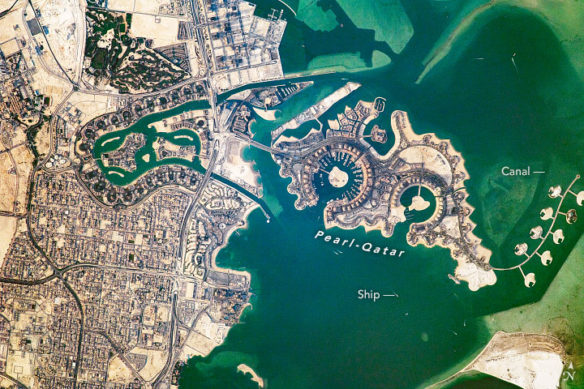
Astronaut photograph ISS053-E-127736 was acquired on October 23, 2017.
The Pearl-Qatar, a man-made island spanning approximately 1.5 square kilometers (0.6 square miles), extends from the mainland, and once fully completed, The Pearl will create over 32 kilometers of new coastline.
In 2004, when the project was first revealed, the initial cost of constructing the island stood at $2.5 billion. It is now believed the project will cost $15 billion upon completion.
By Andi Hollier, NASA / Earth Observatory;
An astronaut flying aboard the International Space Station took this long lens photograph of part of Doha, the capital city of Qatar, located on the northeastern coast of the Arabian Peninsula.
The Pearl-Qatar, a man-made island spanning approximately 1.5 square kilometers (0.6 square miles), extends from the mainland and is among the first properties in Qatar that can be owned by non-Qataris. Deep canals have been cut around the islands, and they lead out into the Persian Gulf. (Click here to see an image of yachts lining the canal at night.)
The Pearl-Qatar infrastructure was built to resemble a string of pearls in recognition of the historical pearl-diving sites upon which the island complex is built. The proposal of the artificial islands started in 2004 and comstruction is expected to end in 2018 with ten precincts, 31 towering buildings, and 4,700 apartments.
With more 2 million inhabitants, Doha is a center of economic activity for the region. The city will host the FIFA World Cup in 2022, the first time the soccer tournament will be held in the Middle East. With this large population and a push for tourism comes challenges in finding sustainable supplies of drinking water.
Qatar has an arid desert climate with hot, long summers (March to September), and annual rainfall is scarce and unpredictable. The Doha Groundwater Basin sits below the city and is mainly used for irrigation. In consequence, the city is turning to desalination of sea water to supply potable water to residents.
Original Article; NASA / Earth Observatory (04-02-2018)
Land reclamation has harmed marine life: Survey; The Peninsula Quatar (03-05-2017)
Survey shows that land reclamation has adverse effects on coral reefs and fish quantity has decreased in the last five years in the coastal areas of Doha, Quatar…
What Happens to a Coral Reef When an Island is Built on Top? the Washington Post (07-11-2015)
Seven such coral reefs are being turned into islands, with harbors and landing strips by the Chinese military, and it is destroying a rich ecological network. “It’s the worst thing that has happened to coral reefs in our lifetime…”
Land reclamation plan endangers protected marine area, Malta; Malta Today (10-03-2016)
Built on Sand: Singapore and the New State of Risk, Harvard Design Magazine (09-07-2015)
The island’s expansion has been a colossal undertaking. It is not merely a matter of coastal reclamation: Singapore is growing vertically as well as horizontally. This means that the nation’s market needs fine river sand—used for beaches and concrete—as well as coarse sea sand to create new ground…
The Conservation Crisis No One Is Talking About, By John R. Platt, TakePart (09-21-2016)
Beaches around the world are disappearing. No, the cause isn’t sea-level rise, at least not this time. It’s a little-known but enormous industry called sand mining, which every year sucks up billions of tons of sand from beaches, ocean floors, and rivers to make everything from concrete to microchips to toothpaste…
The Economist explains: Why there is a shortage of sand; The Economist (04-24-2017)
It may be plentiful, but so is the demand for it…
Sand, Rarer Than One Thinks: A UNEP report (GEA-March 2014)
Despite the colossal quantities of sand and gravel being used, our increasing dependence on them and the significant impact that their extraction has on the environment, this issue has been mostly ignored by policy makers and remains largely unknown by the general public.
In March 2014 The United Nations released its first Report about sand mining. “Sand Wars” film documentary by Denis Delestrac – first broadcasted on the european Arte Channel, May 28th, 2013, where it became the highest rated documentary for 2013 – expressly inspired the United Nations Environment Programme (UNEP) to publish this 2014-Global Environmental Alert.
Sand Wars, An Investigation Documentary, By Multi Award-Winning Filmmaker Denis Delestrac (©-2013)
“The construction-building industry is by far the largest consumer of this finite resource. The traditional building of one average-sized house requires 200 tons of sand; a hospital requires 3,000 tons of sand; each kilometer of highway built requires 30,000 tons of sand… A nuclear plant, a staggering 12 million tons of sand…”
As of 2011-2012, when investigative filmmaker Denis Delestrac and team, were collecting and unveiling sand mining datas and information from the professionals involved, “…the sand business was estimated to be a $70 billion industry, worldwide…!”—Denis Delestrac (©-2013)









